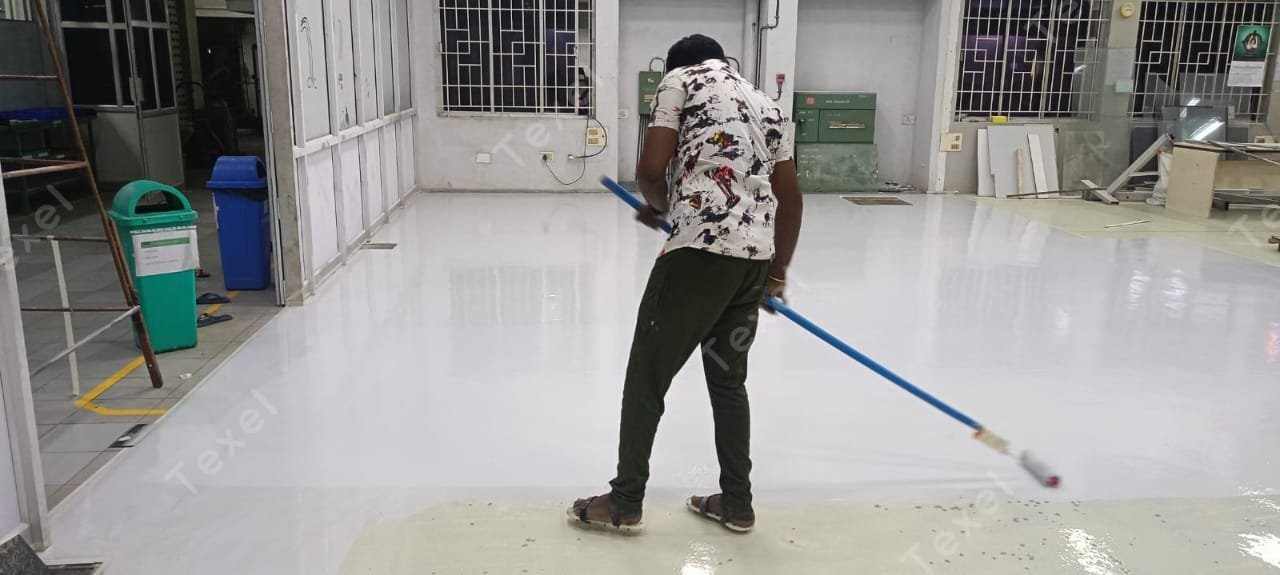IMPORTANCE OF EPOXY FLOORING IN THE
GARMENT INDUSTRY
INTRODUCTION
In
the garment industry, flooring plays a crucial role in ensuring both safety and
efficiency. The type of flooring used in garment factories must withstand heavy
foot traffic, the movement of machinery, and the potential for spills from
various chemicals or liquids. The right flooring choice can significantly impact the
efficiency, safety, and overall productivity of a garment manufacturing
facility.
HOW
EPOXY FLOORING BECOMES A PERFECT SOLUTION FOR GARMENT INDUSTRY FLOORING ?
Epoxy
flooring is specifically engineered to address and overcome the challenges that
are commonly faced by traditional flooring options in the garment industry.
Here is how epoxy flooring effectively mitigates these issues:
1.
Durability Against Wear and Tear
Problem: Normal flooring
materials like vinyl, tiles, or untreated concrete can wear down quickly under
the constant foot traffic, movement of machinery, and the heavy loads often
found in garment factories. This wear leads to cracks, dents, and overall
degradation, requiring frequent repairs and replacements.
Solution: Epoxy floor is
highly durable and resistant to abrasion, impact, and wear. Its robust surface
can handle the rigors of a busy manufacturing environment without deteriorating
quickly, thereby reducing maintenance needs and extending the lifespan of the
floor.
2.
Resistance to Chemicals and Stains
Problem: Traditional
flooring materials can absorb chemicals, dyes and cleaning agents, leading to
stains, corrosion, and damage, which can be difficult and costly to repair.
Solution: Epoxy material is
non-porous and highly resistant to chemicals, preventing spills from
penetrating the surface and causing damage. This makes it much easier to clean
and maintain, ensuring that the floor remains in good condition even after
exposure to harsh substances.
3.
Safety Concerns: Slip and Fire Resistance
Problem: Floors in garment
factories can become slippery due to spills, which increases the risk of
accidents.
Solution: Epoxy floors can
be formulated with slip-resistant additives, providing a safer walking surface
even in areas prone to spills. It can also be designed to be fire-resistant,
helping to protect the facility and its workers in the event of a fire, and
meeting stringent safety regulations.
4.
Maintenance and Hygiene Challenges
Problem: Traditional
flooring options can be difficult to clean, especially when stains set in or
when cracks and seams collect dirt and bacteria.
Solution: The seamless,
non-porous nature of epoxy makes it easy to clean and maintain. It resists
stains, dust, and bacteria buildup, which is crucial for maintaining a hygienic
environment.
5.
Aesthetic and Organizational Limitations
Problem: Standard
flooring materials may not offer much flexibility in terms of appearance or
functionality, making it difficult to create a professional-looking environment.
Solution: Epoxy floor is
highly customizable, available in various colors, patterns, and finishes. This
allows garment factories to design floors that not only look attractive but
also help in organizing the workspace, such as by designating specific areas
for different activities or by marking pathways.
6.
Cost Inefficiency Over Time
Problem: Traditional
flooring may have a lower upfront cost but often incurs higher long-term
expenses due to frequent repairs, replacements, and increased maintenance
requirements.
Solution: Although epoxy application
may have a higher initial installation cost, its durability and low maintenance
needs make it a more cost-effective solution in the long run. The reduced need
for repairs, combined with its longevity, means that factories can save money
over time.
7.
Environmental Concerns
Problem: Some flooring
materials may contribute to poor indoor air quality, especially if they release
volatile organic compounds (VOCs).
Solution: Many modern epoxy
formulations are available with low-VOC formulations, contributing to better
indoor air quality.
8.
Dust-free Flooring
Problem: Traditional
flooring options, especially carpet, can contribute to dust and allergen
accumulation. Even tile and wood, with their seams and cracks, can harbor dust.
Solution: Epoxy flooring
system is particularly advantageous in creating a dust-free environment. The
seamless nature of epoxy reduces dust collection and makes it easier to clean
thoroughly.
9.Cleanliness
Problem:
Tile
requires regular mopping, and grout lines may need deep cleaning to prevent the
buildup of dirt and mold. Wood floors need regular sweeping and may require
specialized cleaning products to maintain their finish and cleanliness.
Solution:
Floors
with epoxy application can be easily cleaned with simple sweeping and mopping,
and it doesn’t require specialized cleaning products. Epoxy floors do not trap
dust or debris, making them easier to maintain in a clean state.
CONCLUSION
Industrial
epoxy flooring is the long-lasting
solution for garment industry flooring. It also enhances operational
efficiency, reduces maintenance costs, and ensures a safer and cleaner
workspace. Its benefits make epoxy flooring a crucial investment for any
garment manufacturing facility, supporting both productivity and the quality of
the finished products. The right flooring solution can significantly impact the
overall operation, from the movement of machinery and materials to the comfort
and safety of workers.
